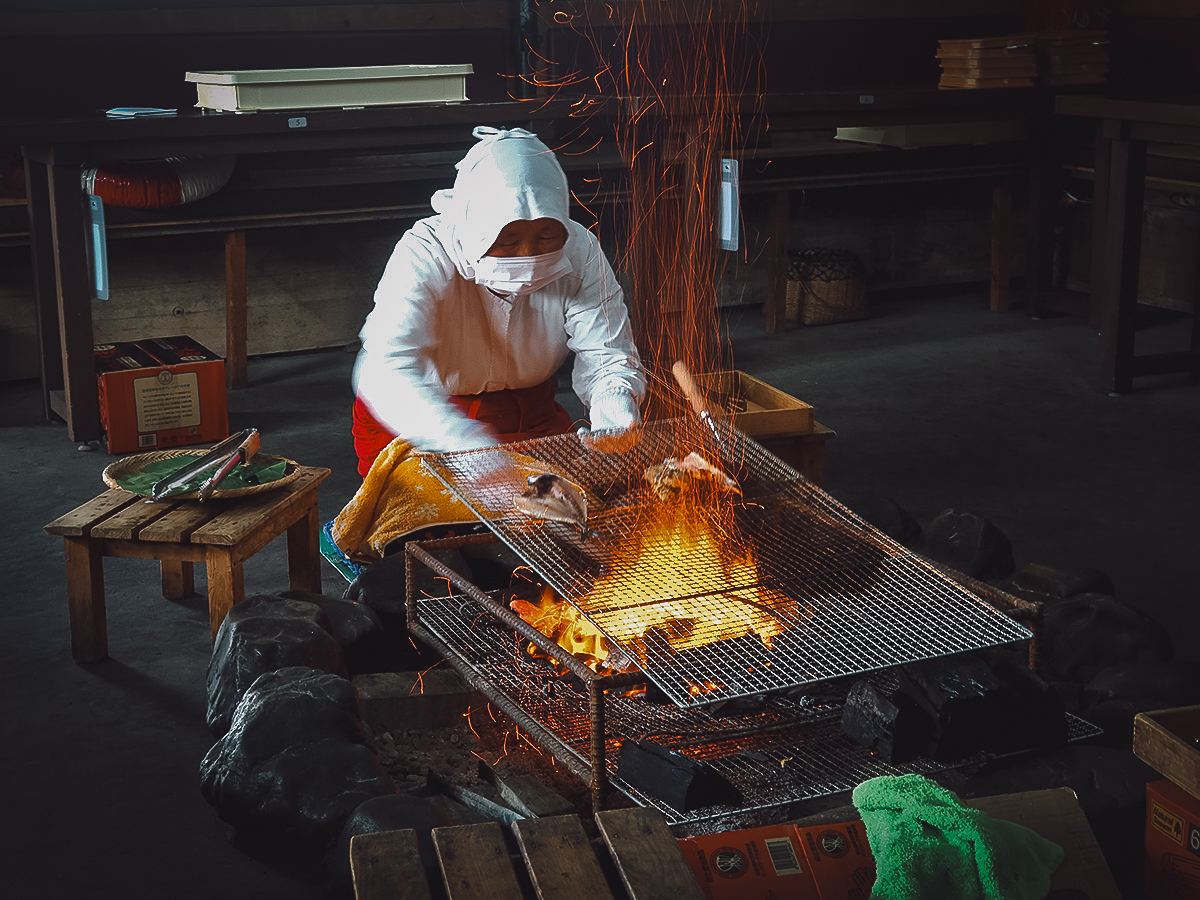SUMMARY HIGHLIGHTS
- Staying near Iseshi Station in Ise is ideal.
- The Kintetsu Rail 5-Day Pass Plus is great for exploring the Shima Peninsula.
- Enjoying a seafood meal prepared by ama divers is a must.
Sometimes, emotion catches me when I least expect it. It happened again, not long after arriving at Matoya Bay on the Shima Peninsula.
I had boarded a bus in Toba, headed for a small fishing village tucked away in a quiet corner of the bay. The ride, just under an hour, would take me to one of the more remote parts of Ise-Shima, far from the usual tourist trail.
I’m always grateful for the experience of travel, but there’s something especially meaningful about venturing into the lesser-known pockets of Japan. These experiences tend to stay with you longer – they resonate more deeply and make you realize just how fortunate you are to be there.
I got off the bus at my stop and began searching for the ama hut. I was excited to meet the ama divers and enjoy the seafood meal they’d prepare for me, but I didn’t expect to feel so overcome with gratitude. The moment just hit me, I guess, not just for what I was about to experience, but because I knew what a privilege this was.
I had enjoyed many terrific experiences in the four weeks I’d been in Japan, but like my temple stay in Koyasan, this was going to be something I’d remember forever.
VISIT ISE-SHIMA QUICK LINKS
To help you plan your trip to the Shima Peninsula, we’ve compiled links to recommended hotels, tours, and other travel-related services here.
HOTELS
Top-rated hotels around Iseshi Station, one of the most convenient areas to stay for first-time visitors to Ise-Shima.
- Luxury: Isegekusando Iseshinsen
- Midrange: Ise Pearl Pier Hotel
- Budget: Mizuhokan
EXPERIENCES
- Sightseeing Tour: Ise-Shima Tour
- Ama Culture: Ise Grand Shrine and Ama culture experience
- Pearl Workshop: Hands-on Pearl Harvesting Workshop
OTHER SERVICES
GUIDE TABLE OF CONTENTS
ISE-SHIMA AT A GLANCE
Located in eastern Mie Prefecture, the term Ise-Shima refers to the Shima Peninsula. It encompasses the cities of Ise, Toba, Shima, and parts of Minami-Ise[1].
Ise-Shima spans a large area – including a national park measuring roughly 55,544 hectares[2] – but among its most popular destinations are the cities of Ise and Toba.
Ise is best known for Ise Jingu, a shrine complex housing the most sacred Shinto shrines in Japan, while Toba is where you’ll find Mikimoto Pearl Island, the birthplace of the world’s first cultured pearls. Together with Shima, Toba is home to the most active ama divers in Japan, the legendary women who free-dive for shellfish without scuba equipment.
Thanks to Ise Shrine, the Shima Peninsula is popular with domestic tourists, but it remains a relatively unknown destination for many international visitors.
BEST TIME TO VISIT THE SHIMA PENINSULA
As with many places in Japan, spring and autumn are ideal times to visit Ise-Shima. The weather is pleasant and the scenery is breathtaking – think soft pink cherry blossoms in spring and fiery shades of red, orange, and yellow in the fall.
If you want to catch the cherry blossoms, then aim for late March to early April. For autumn foliage, the best time to visit is around late October to early December.
If you like oysters, then you may want to visit Ise-Shima in winter instead. Toba is known for its oysters, and many restaurants in the Uramura area offer all-you-can-eat oyster buffets from around November until the end of March[3].
WHERE TO STAY IN ISE-SHIMA
In my opinion, the area around Iseshi Station in Ise City is one of the most convenient places to stay in Ise-Shima. Iseshi Station services both the JR and Kintetsu rail networks, so staying near the station will make it easier to get around.
I’ve created the color-coded map below to help you understand where these recommended areas are. Click on the link for a live version of the map. (Please note that marked areas are approximations only)
BLUE – Around Iseshi Station
ORANGE – Toba
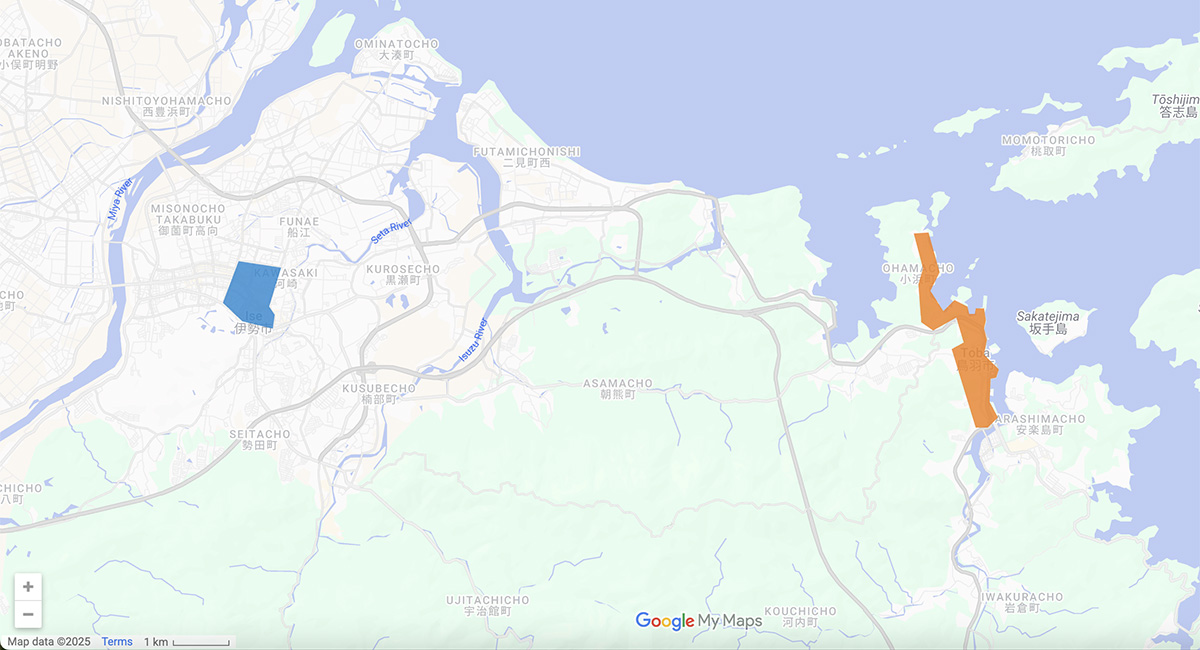
AROUND ISESHI STATION
As advised, I think the area around Iseshi Station is one of the most convenient areas to stay in Ise-Shima. It’s one of two main railway stations in Ise and serves both the JR and Kintetsu rail networks.
You can check Booking.com for hotel listings around Iseshi Station. Here are some of the top-rated hotels in the area:
- Luxury: Isegekusando Iseshinsen
- Midrange: Ise Pearl Pier Hotel
- Budget: Mizuhokan
TOBA
If you’d prefer to stay by the coast, then Toba is a great alternative to Ise. Not only is it more scenic, but it’s roughly halfway between Ise and Shima, making it a convenient base for visiting attractions in both areas.
You can check Booking.com or Agoda for hotel listings in Toba. Here are some of the top-rated hotels in the area:
- Luxury: Toba International Hotel
- Midrange: Toba Grand Hotel
- Budget: Kaigetsu
THINGS TO DO IN ISE-SHIMA
Pay Your Respects at Japan’s Most Sacred Shrines
“Naiku is very special to us”, my Japanese friend told me. “It’s one of my favorite places in Japan. Even the air feels different there.”
Other than being clean and crisp, I’m not sure I noticed the air being much different, but it was clear to me how important the Inner Shrine was to the Japanese. It’s so revered that every Japanese person is encouraged to visit Naiku at least once in their lifetime.
Located in Ise City, Ise Jingu is considered the most sacred Shinto shrine in Japan. It consists of two main shrines – the Inner Shrine or Naiku (pictured below) and the Outer Shrine or Geku.
Naiku enshrines Shinto’s most venerated deity, the Sun Goddess Amaterasu Omikami, while Geku enshrines Toyouke Omikami, the Shinto deity who provides food for the Sun Goddess[4]. Between the two, Naiku is the more venerated shrine and receives far more visitors. This is because the Imperial family is believed to be the direct descendants of Amaterasu.
Despite the many pilgrims who visit the Inner Shrine, Naiku remains a peaceful place, nestled in a heavily forested area with walking trails, a sacred river, and a number of smaller shrines.
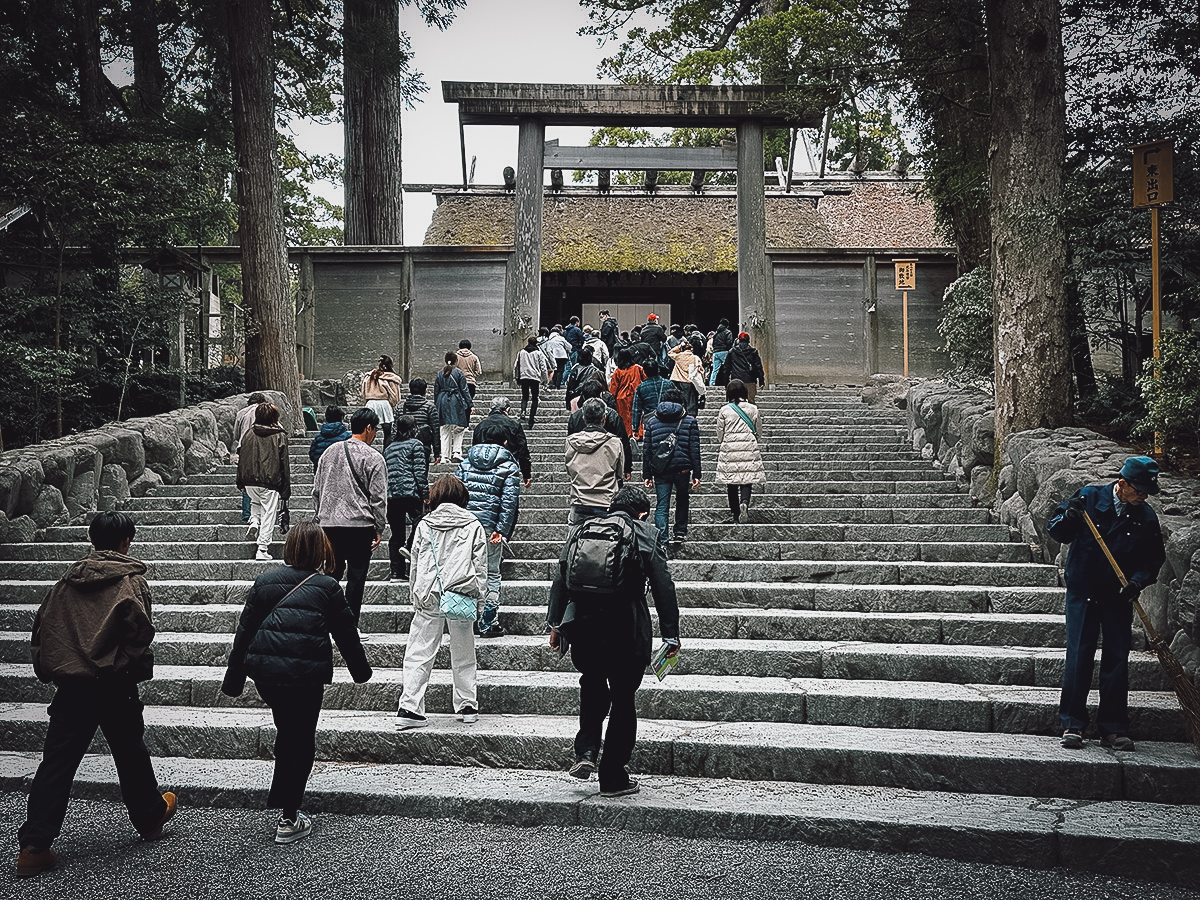
Located around 4 km (2.5 miles) north of Naiku, the Outer Shrine or Geku (pictured below) receives considerably fewer visitors, but it’s an interesting place to visit nonetheless.
Like the Inner Shrine, the Outer Shrine is rebuilt from scratch every twenty years. This unique practice is rooted in Shinto beliefs, emphasizing the cyclical nature of life and the importance of renewal[5].
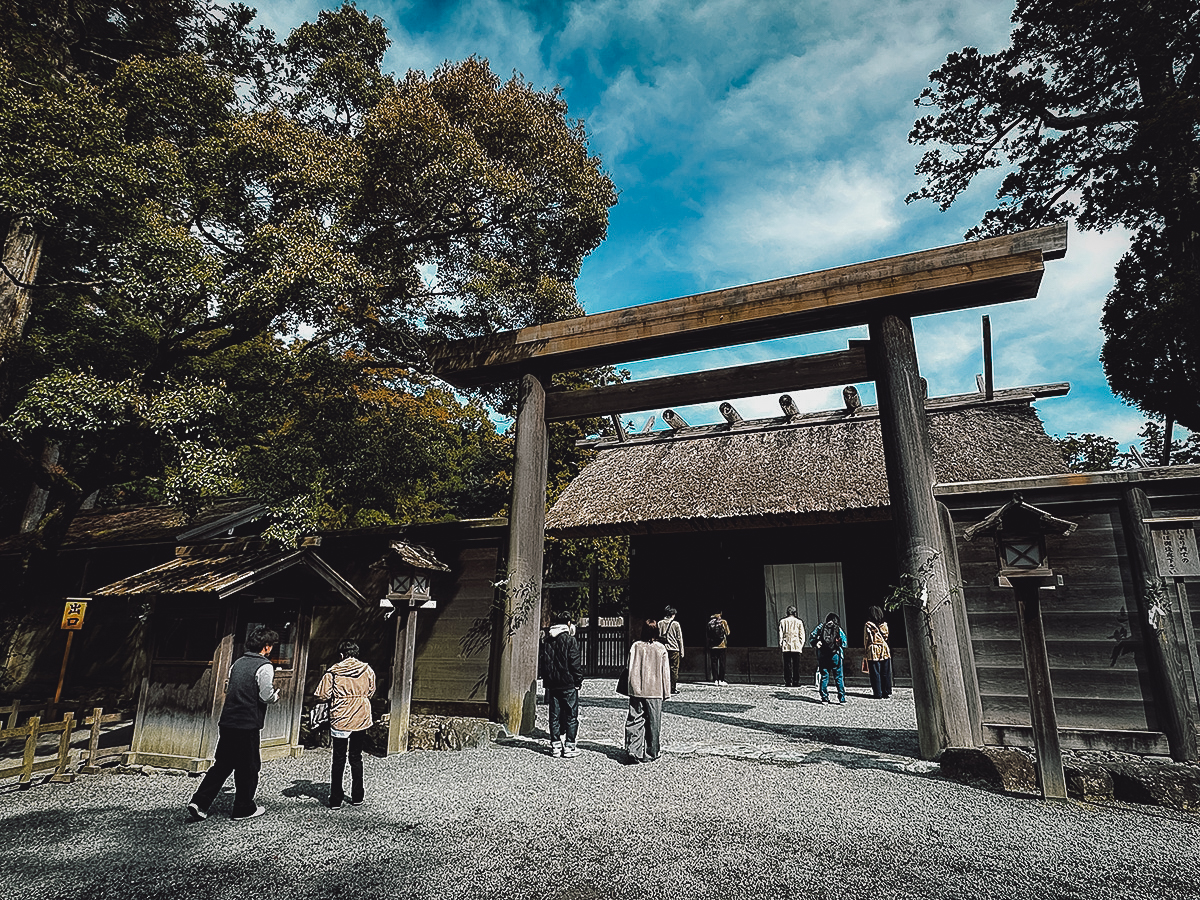
Try Akafuku and Other Goodies at Oharaimachi
What makes a trip to Naiku even more eventful is Oharaimachi, the historic approach to the Inner Shrine. Stretching for nearly a kilometer, it consists of traditional wooden buildings occupied by dozens of restaurants, shops, and cafes.
I had a blast perusing the many shops of Oharaimachi after visiting the Inner Shrine. Aside from buying vintage sake cups and small daruma dolls, I stuffed my face with tasty tidbits like Uramura oysters, grilled turban shells, and boiled shirasu.
When making your way down Oharaimachi, look for Okage Yokocho, a side alley with shops and restaurants that was made to look like an Edo/Meiji-period village.
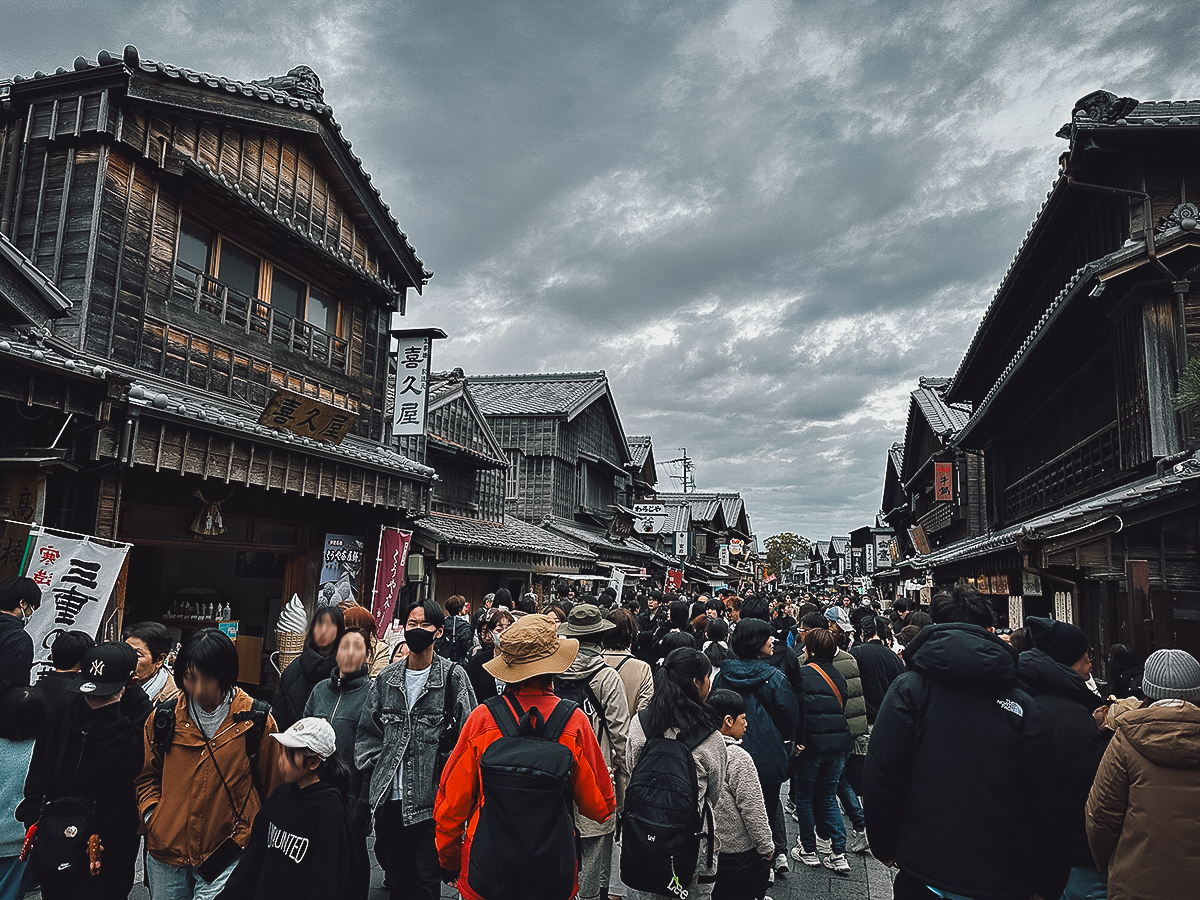
Before visiting Ise, my Japanese friend told me not to miss akafuku, a regional type of mochi topped with lightly sweetened anko (red bean paste). It’s long been associated with the Ise pilgrimage and is a must-try for people visiting Naiku.
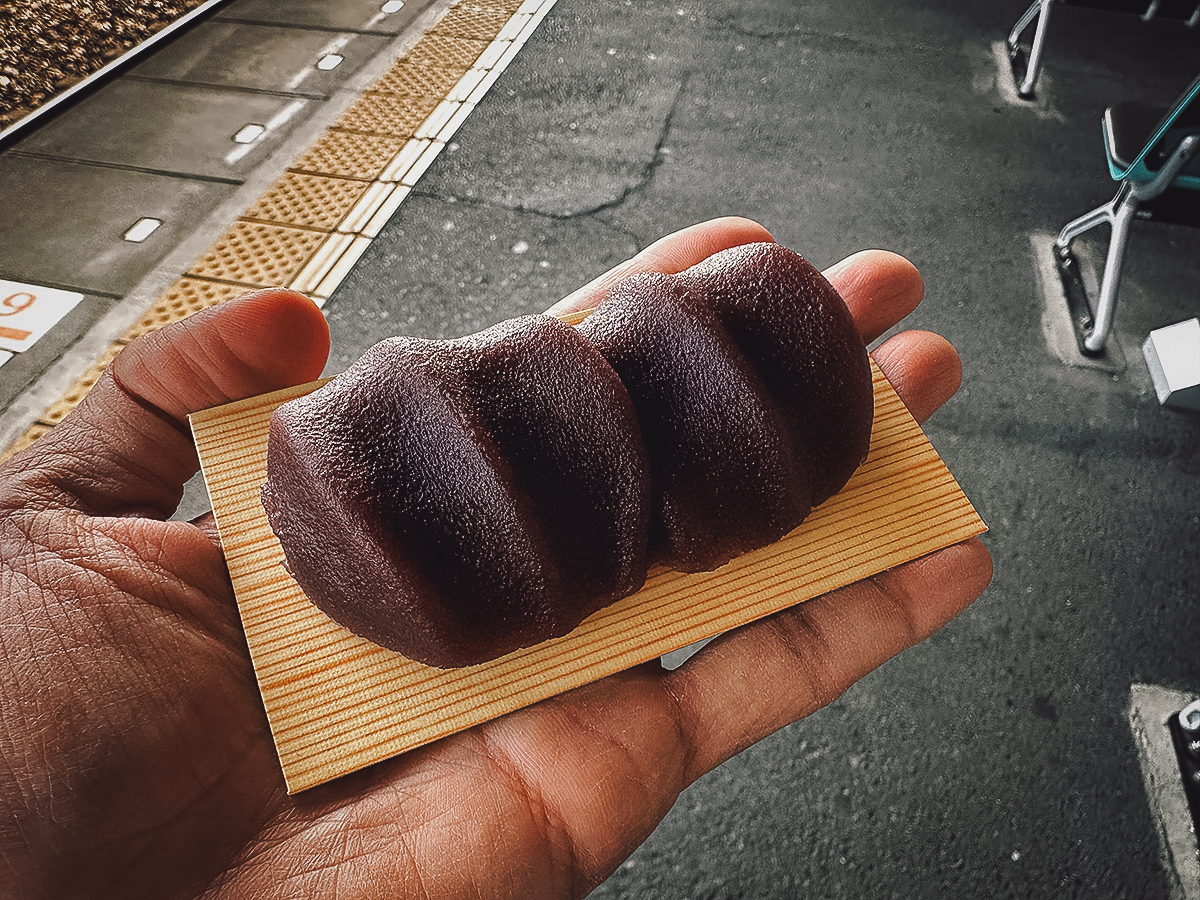
Make a Quick Stop at Meoto Iwa
On your way to Toba from Ise, you can make a quick stop in the small town of Futami to see these two sacred rocks known as Meoto Iwa (literally “wedded rocks”).
Located in the ocean near Futami-Okitama Shrine, the rocks are connected by a shimenawa rope and are meant to symbolize the union of the Shinto deities Izanagi and Izanami, the mythical couple believed to be the creators of Japan[6].
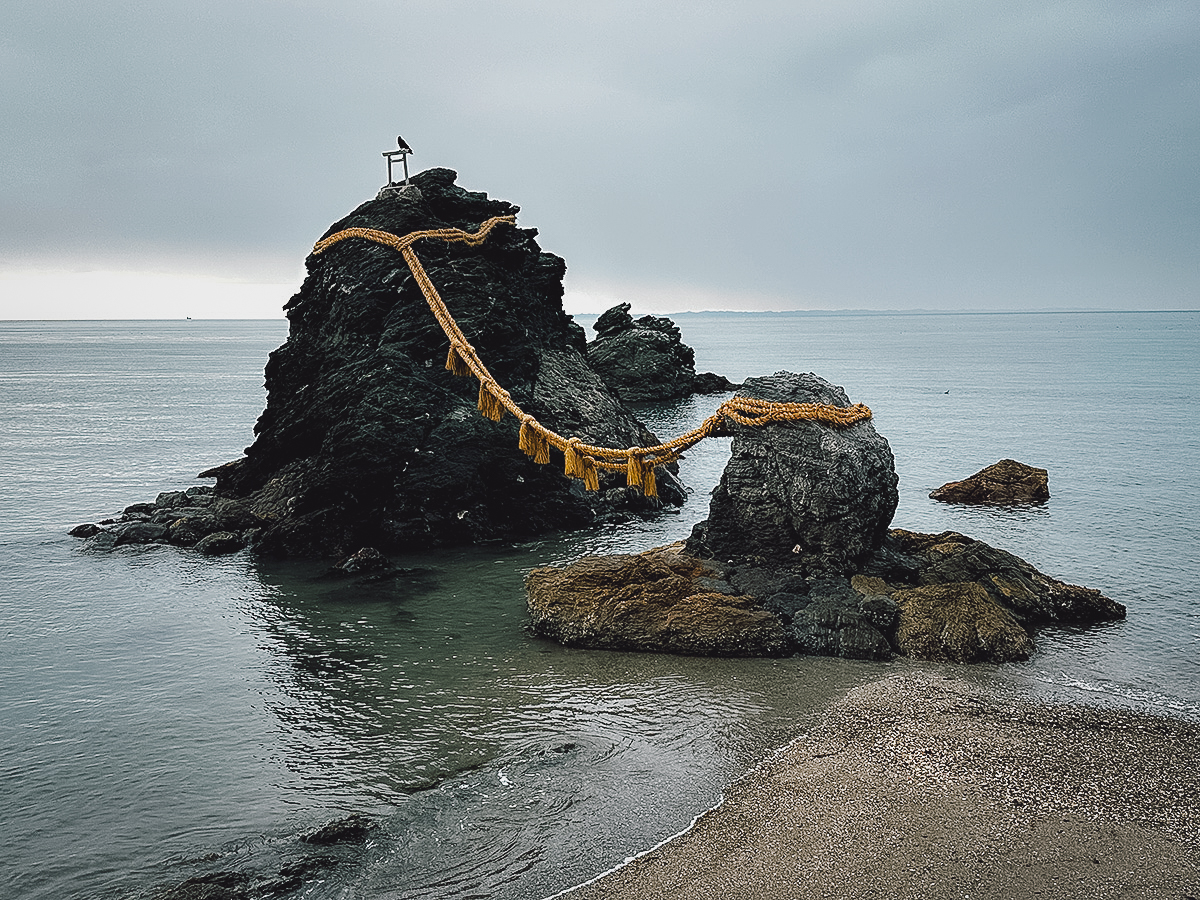
Watch Ama Divers in Action at Mikimoto Pearl Island
My mother was in the jewelry business and she used to tell me that Mikimoto pearls were the most perfect-looking pearls in the world. Many would agree.
Having heard so much about these pearls, I was excited to visit the very island where Kokichi Mikimoto successfully cultivated the world’s very first cultured pearls. Located in Toba Bay, the island has been named Mikimoto Pearl Island in his honor.
The price of admission to the island is a little steep, but it does feature an informative pearl museum and these fascinating ama diver demonstrations. Ama are traditional female free divers (no scuba gear) who’ve been harvesting seafood and pearls in Toba’s waters for over two thousand years[7]. Seeing them in action was a real privilege.
If you’re looking to buy certified Mikimoto pearls, there’s an upscale jewelry shop on the island, along with a restaurant.
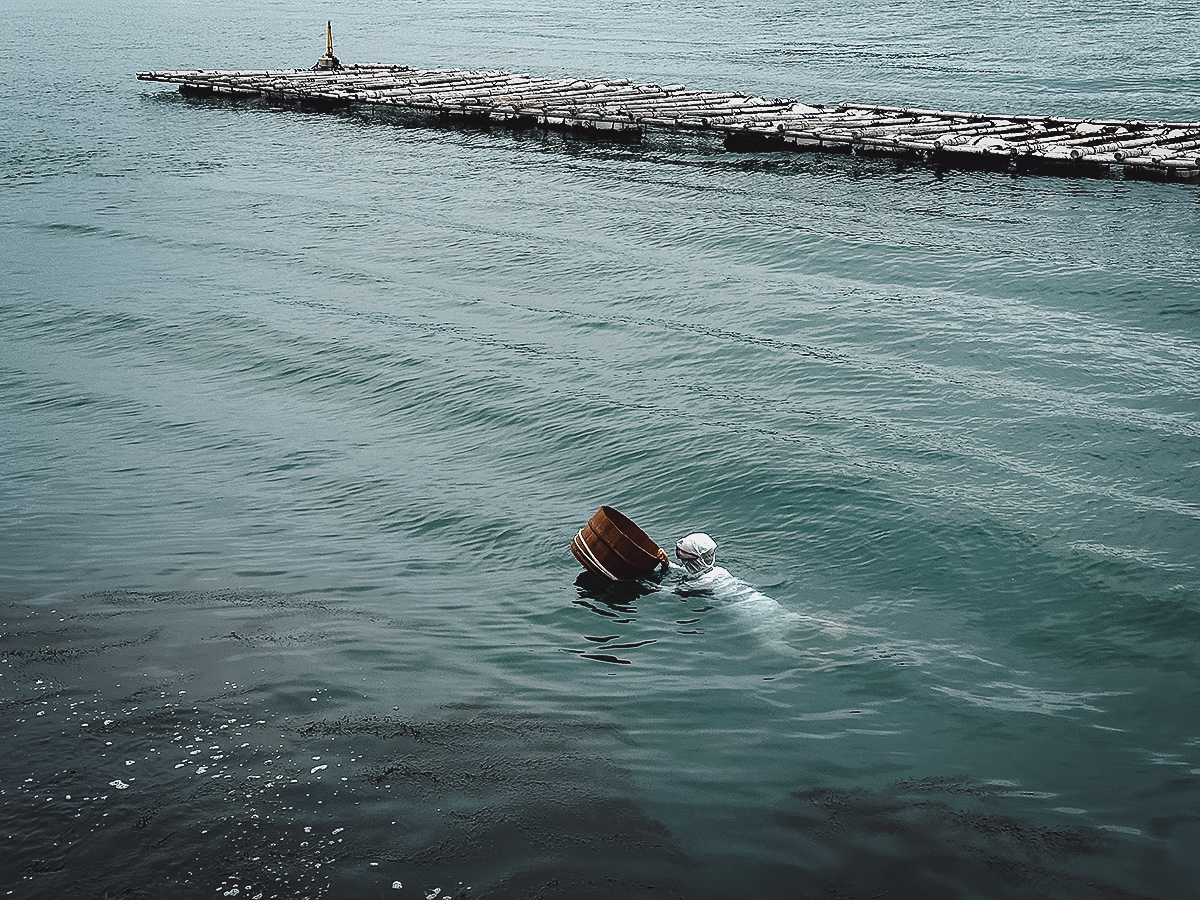
Enjoy a Seafood Meal Prepared by Ama Divers
Seeing the ama divers at Mikimoto Pearl Island was interesting, but sitting down to a seafood meal prepared by retired ama was a special experience. Thanks to Hachiman Kamado, I was able to enjoy this simple but unforgettable meal in Matoya Bay.
Ama diving is a dying tradition, so it was inspiring to see these former divers keeping their culture alive, not just through food, but by sharing their stories with visitors. We even took part in a cultural dance after our meal!
One of the ama at Hachiman Kamado was a sprightly 93 years old. She started at the age of 8 and continued diving until her retirement at 80. Wow!
If you enjoy unique cultural experiences, then I highly recommend booking a seat at Hachiman Kamado. I took a bus there on my own, but you can also take their free shuttle bus from Toba Station.
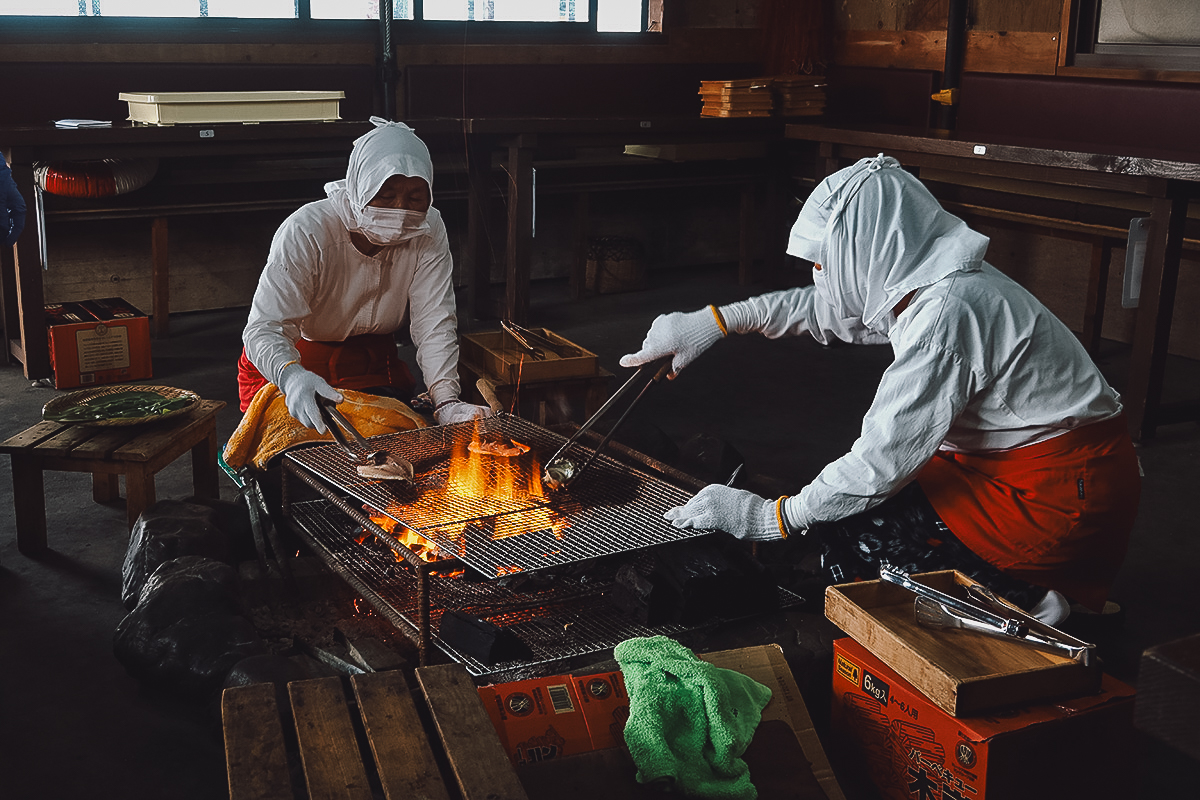
Go Cruising in Ago Bay
Located in Shima City, less than an hour south of Toba, Ago Bay is known for its jagged coastline and scattering of small islands. This was where Kokichi Mikimoto set up his pearl farm after successfully cultivating the world’s first cultured pearl.
Aside from a few pearl shops, the main draw in Ago Bay is a one-hour sightseeing cruise aboard European-style ships that depart from Kashikojima, the largest island in the bay. It takes you out into the bay before circling back.
To be honest, I found the cruise a little underwhelming, so I took the train to Shima-Yokoyama Station and made the 45-minute walk (each way) to the Yokoyama Observation Deck (pictured below). The views of the bay are much better from up here and well worth the effort.
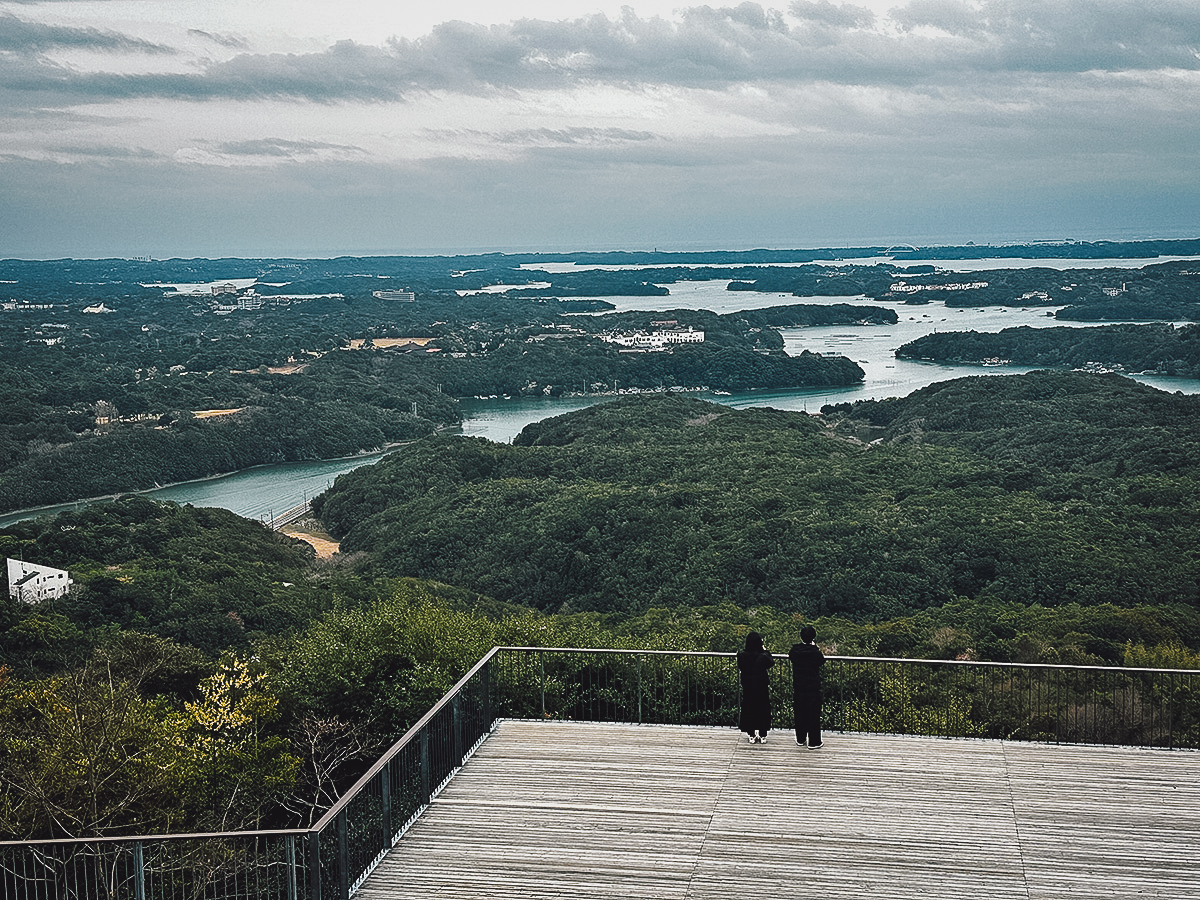
DAY TRIPS FROM ISE-SHIMA
Matsusaka
Kobe Beef’s reputation precedes itself, but it’s just one of many highly-prized wagyu brands in Japan. Other sought-after beef brands include Hida, Omi, Saga, Yonezawa, and Matsusaka.
If you enjoy a good steak, then you’re in luck because Matsusaka City is located just 15-20 minutes northwest of Ise. Produced from virgin female Japanese Black cattle raised in Matsusaka, Matsusaka Beef – together with Kobe and Omi – is considered by many to be one of the top three wagyu brands in Japan.
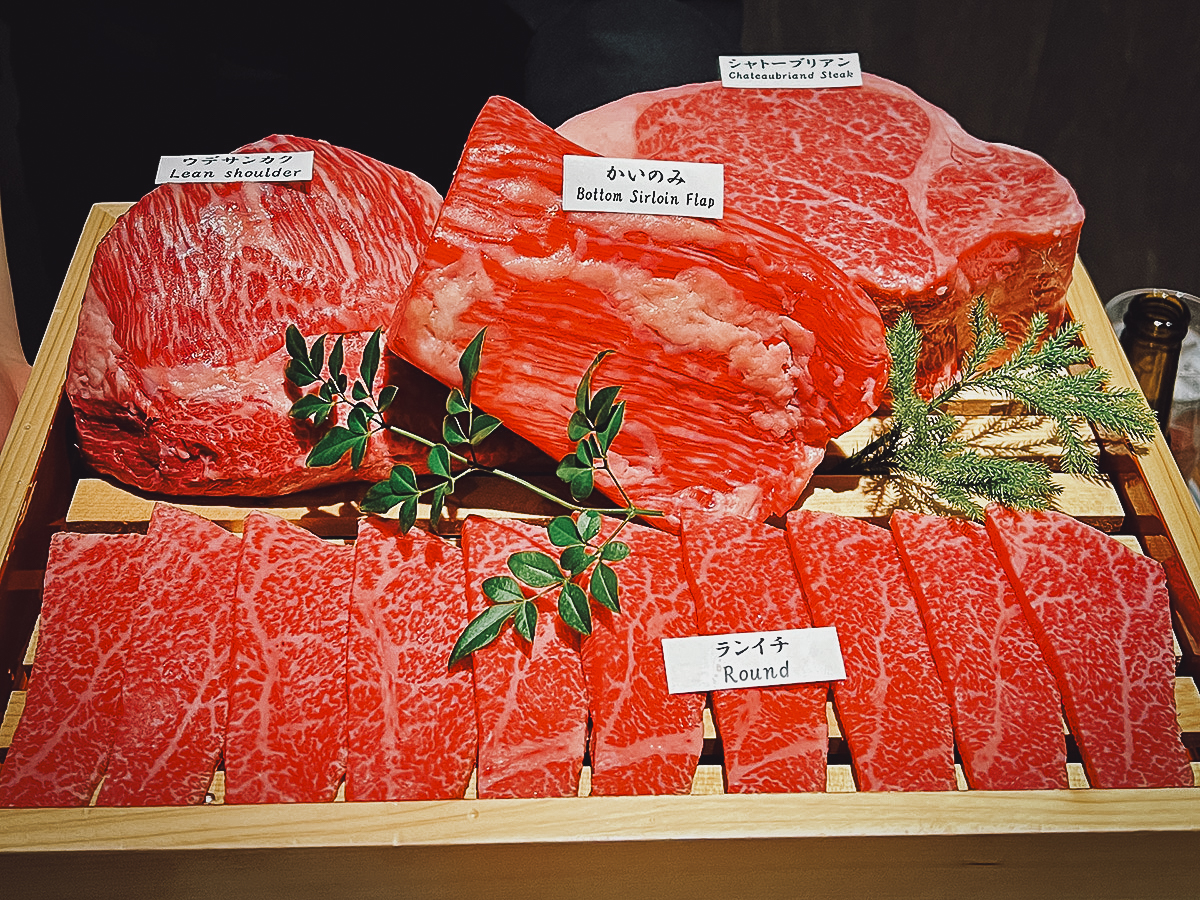
Iga Ueno
Have you ever fantasized about being a ninja as a kid? If you have, then a day trip to Iga Ueno – around an hour and a half northwest of Ise – is a must. Together with Koka in Shiga Prefecture, it’s considered the ninja capital of Japan.
Once home to one of Japan’s most renowned ninja schools, Iga Ueno celebrates its ninja heritage at the Iga-ryu Ninja Museum (pictured below). It’s a small but fascinating museum with well-curated exhibits, a traditional ninja house, live ninja demonstrations, and hands-on activities where you can try real ninja weapons like shuriken, throwing knives, and blow darts.
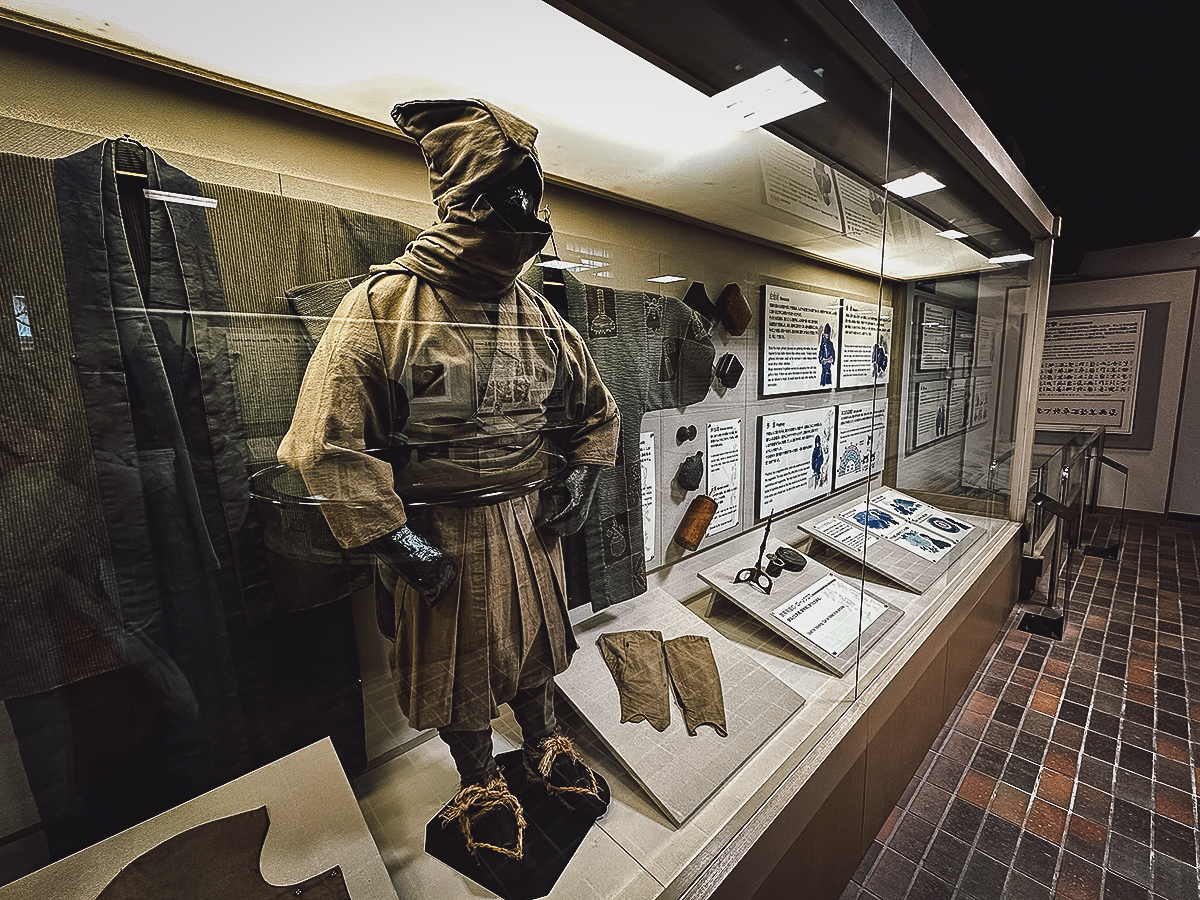
VISIT ISE-SHIMA FAQs
Can I visit Ise-Shima on a day trip from Osaka?
Yes, you can. It takes a little over two hours to get to Ise from Osaka on a Kintetsu limited express train.
Is it easy to get around in Ise-Shima?
Yes, especially if you have a Kintetsu Rail 5-Day Pass Plus. It’ll give you unlimited access to the Kintetsu rail network (except limited express trains), along with unlimited rides on Mie Kotsu and Toba City Kamome buses.
If you don’t have a rail pass, then getting an IC card is a good idea. It won’t save you on the cost of transportation, but it will save you from the hassle of having to buy single-journey tickets each time.
Is the Kintetsu Rail Pass worth it?
Yes, the Kintetsu Rail 5-Day Pass Plus is a great pass for exploring Ise-Shima. The Kintetsu rail network is extensive in Mie Prefecture, so I never had to use JR trains. Personally, I saved a total of JPY 6,990 on transportation and admission with the pass.
The 5-Day Pass will work as well, but it doesn’t include rides on local buses. Some attractions, like the Inner Shrine and Meoto Iwa, are a little harder to get to by rail alone.
THE FINAL SAY
Ise-Shima isn’t a priority for most first-time visitors to Japan, but if you’ve already been to the popular tourist hotspots of Osaka, Kyoto, and Nara, then it may be time to book a trip to this less-visited part of the Kansai region.
The Shima Peninsula doesn’t offer the same excitement as Osaka or Tokyo, but it will show you a quieter, more contemplative side of Japan – one that’s rooted in culture, spirituality, nature, and tradition.
Disclosure
This Ise-Shima travel guide contains affiliate links, meaning we’ll earn a small commission if you make a booking at no additional cost to you. We only recommend products and services that we use ourselves and firmly believe in. We really appreciate your support as it helps us make more of these free travel guides. Arigato gozaimasu!
References
1. Ise-Shima. Wikipedia.
2. Ise-Shima National Park. National Parks of Japan.
3. If you want to eat all-you-want oysters, then you must visit Uramura in Toba City! Mie, Once in Your Lifetime.
4. Outer Shrine (Geku). japan-guide.com.
5. Why is the building at Ise Jingu rebuilt every twenty years? Brainly. (2023, June 19).
6. Cartwright, Mark (2012, December 6). Izanami and Izanagi. World History Encyclopedia.
7. Ama (diving). Wikipedia. (2004, June 4).

